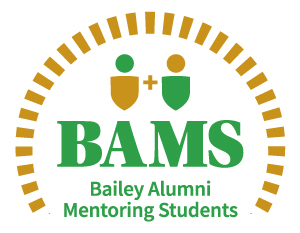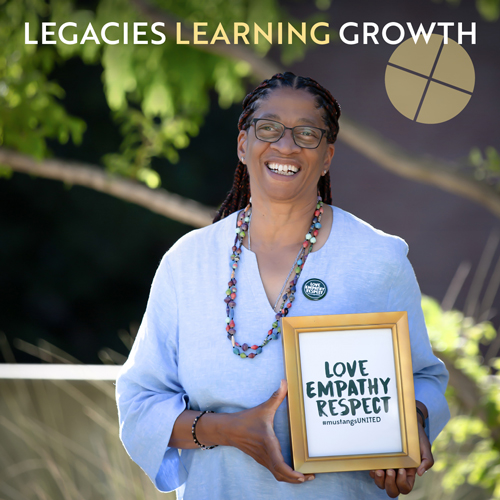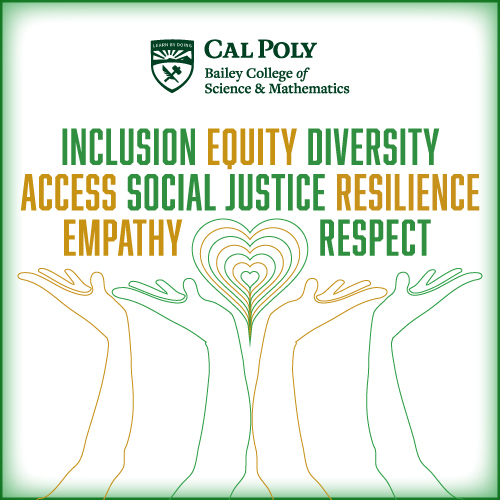BEACoN Scholars Shine Brightly
![]() Liberal studies student and BEACoN Research Scholar Isabella Contreras presenting her research poster on "The Role of Identity-Based and Cultural Organizations in the Persistence of Latinx Aspiring Teachers."
Liberal studies student and BEACoN Research Scholar Isabella Contreras presenting her research poster on "The Role of Identity-Based and Cultural Organizations in the Persistence of Latinx Aspiring Teachers."
BAILEY BEACON STUDENTS EXPERIENCE RESEARCH, LEARN LIFELONG SKILLS, GAIN CONFIDENCE AND EXPAND HORIZONS
OCTOBER 2025
by nick wilson / PHOTOS BY MARIYA AVTANSKA
![]()
BEACoN, which stands for Believe, Educate and Empower, Advocate, Collaborate, Nurture; offers research opportunities to underrepresented students. The program officially began in 2018 and is overseen by the Office of University Diversity and Inclusion. Students from any major can apply to become BEACoN Research Scholars, earning stipends of $2,000 per quarter to engage in research with a Cal Poly faculty mentor.
Safiya Rufino didn’t see herself as a research scientist before joining Cal Poly’s BEACoN program to investigate antibiotic production from ancient microbes, a concept that seems like science fiction from “Jurassic Park” but is, in fact, real.
Rufino, a microbiology and food science double major, felt out of place at first, but developed self-assurance through BEACoN’s faculty and peer guidance.
“I definitely felt impostor syndrome,” Rufino said. “The Frost (Center) research facility was incredible with all these machines, equipment and tests, but I had no idea what to do with them. Over time, I gained knowledge and confidence. Now I train new members of the lab. This work solidified that I truly want to be a scientist.”
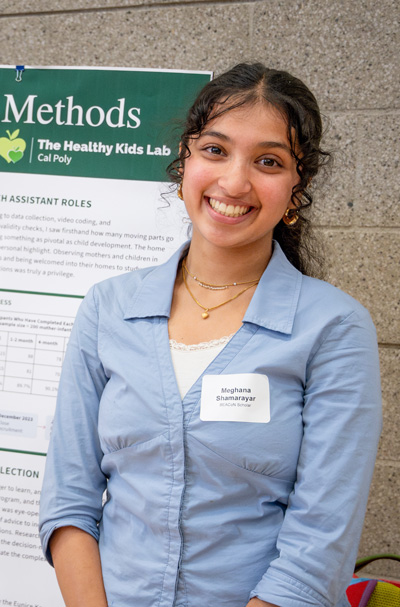 Rufino and lab partner Kaitlyn Calligan worked under Rachel Johnson, a postdoctoral fellow through the Frost Teacher-Scholar program, and chemistry and biochemistry Professor Katharine Watts. Calligan had similar feelings initially.
Rufino and lab partner Kaitlyn Calligan worked under Rachel Johnson, a postdoctoral fellow through the Frost Teacher-Scholar program, and chemistry and biochemistry Professor Katharine Watts. Calligan had similar feelings initially.
“I really didn’t think I could be doing this,” said Calligan, a microbiology major. “I entered an environment where people often don’t look like me. But here I am breaking through that barrier of what representation looks like in science.”
Rufino and Calligan are among the seven Bailey BEACoN Research Scholars who participated in the Frost Summer Undergraduate Research Program (SURP) with funding provided by Bailey College donors through the Undergraduate Research Fund.
"BEACoN is my first formal introduction to research and how to conduct behavioral studies.
Meghana Shamarayar,
BEACoN Research Scholar and public health student
The college’s newly added summer program for Bailey BEACoN Research Scholars, launched in 2025, is an expansion of the existing campuswide program that takes place each winter and spring quarters. And donor support will provide even more opportunities for Bailey College students to participate in BEACoN in future winter and spring quarters.
This year, donors to the Bailey College Undergraduate Research Fund provided Bailey BEACoN Research Scholars with research awards of $4,500 to continue their project full time during the summer as part of the Frost SURP.
“These types of funded research opportunities are so critical because they enable students to dedicate their time to research opportunities that are very influential for their careers, in lieu of taking other jobs that might be less relevant to their professional development,” said Kelly Bennion, BEACoN’s faculty fellow and a psychology professor.
With the rise of antibiotic-resistant microorganisms that cause disease, Rufino and Calligan are analyzing ancient bacterial strains for their potential to produce new antibiotics that have potential to treat illnesses, particularly for bacteria that are resistant to antibiotics.
Professor Emeritus Raul Cano provided the team with 93 ancient bacteria isolated from amber and deep-sea cores. Cano gained recognition in the mid-1990s for extracting yeast from 45-million-year-old amber and then using it to create craft beers at his Fossil Fuels Brewing Company.
“We met with Dr. Cano to learn about his experiences working with amber samples,” Rufino said. “He told us that if we have an idea, we should go for it. He read about amber extraction in ‘Jurassic Park,’ and then he went and did it himself. That is so inspiring. Basically, anything you think you can do, science gives you tools to try.”
The research team studying the ancient bacteria has cultured over 20 microbe strains, screening them for potential antibiotic activity against safe relatives of human pathogens that are not harmful to humans. “It’s been rewarding to see the students grow as scientists,” Johnson said. “It’s amazing to think back to the first time we met compared to now when they’re so very much intellectually driving this project to gather information that will help inform our next steps, which will be to study genetic information and compare modern bacteria to ancient strains.”
At the June BEACoN Research Symposium, Bailey BEACoN Research Scholars presented their work, including statistics major Taiga Sobajima, who collaborated with mathematics Professor Danielle Champney to research strength-based resources for math students to learn outside of class. The research involved assessing various educational tools through faculty and student surveys, including online instructional videos.
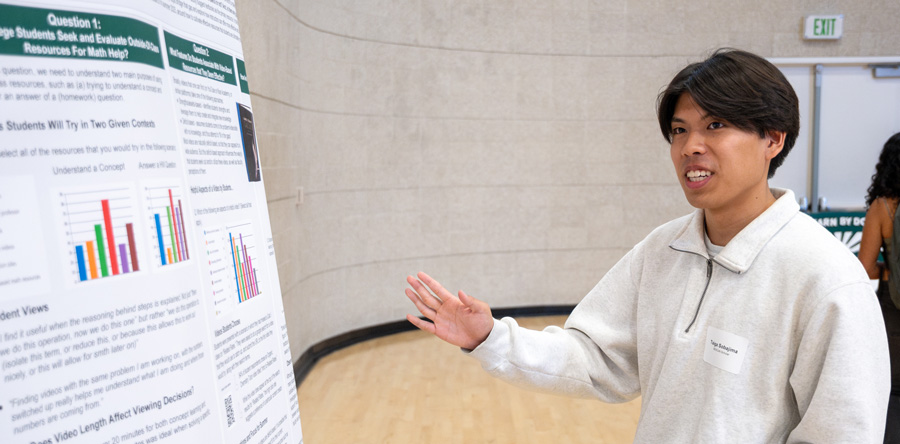 Statistics student and BEACoN Research Scholar Taiga Sobajima presenting his research poster on "Creating Strengths-Based Resources for Math Students in Outside-of-Class Time."
Statistics student and BEACoN Research Scholar Taiga Sobajima presenting his research poster on "Creating Strengths-Based Resources for Math Students in Outside-of-Class Time."
“We want to emphasize strength-based learning because many math videos adopt a deficit-based approach, assuming students have no prior knowledge of the concept and starting from scratch,” Sobajima said. “In reality, students often know some of the concepts, but they may be stuck. Feedback from our surveys indicates that it’s more effective for videos to start at various learning stages and to be concise.”
Other Bailey BEACoN Research Scholar projects included analyzing parent-infant interactions for healthy child development, exploring instructional concepts related to derivatives in calculus and examining the role of campus cultural organizations in shaping teaching aspirations.
“BEACoN is my first formal introduction to research and how to conduct behavioral studies,” said Meghana Shamarayar, a public health major working with Professor Alison Ventura on infant-mother interactions. “I’ve gained interesting and helpful skills by learning how Dr. Ventura writes her protocols and how specific she is when she documents behaviors, like how you define a negative emotion.”
Bennion encouraged BEACoN Research Scholars to be part of solving global challenges: “As a first-generation college student who attended a predominantly white institution, BEACoN is exactly the kind of program I wish had existed at my college campus. Our students’ voices matter, and they will bring expertise and perspectives into the development of new questions, and consequently, the creation of new knowledge and policies.”
![]() Statistics student minoring in data science and BEACoN Research Scholar Chris Liu with his research poster on "Conceptions of Derivatives in Calculus: Extending Beyond Traditional Frameworks." Also in the photo is Liu's BEACoN faculty mentor, mathematics Professor Saba Gerami.
Statistics student minoring in data science and BEACoN Research Scholar Chris Liu with his research poster on "Conceptions of Derivatives in Calculus: Extending Beyond Traditional Frameworks." Also in the photo is Liu's BEACoN faculty mentor, mathematics Professor Saba Gerami.
